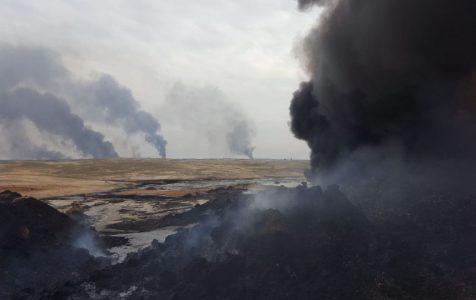
ISIS terrorists are setting oil wells on fire as they retreat
When ISIS retreats from an area in Iraq, they usually bomb anything that supports the local economy. Most of the time, that means they bomb oil fields and refineries.
A burning oil field is a terrible thing. The fire typically takes months to put out. The thick black smoke blots out the sky and the soot coats everything—buildings, streets, people’s skin. White sheep turn completely black.
There is virtually no international funding allocated to clean it up, according to Wim Zwijnenburg, the lead researcher of a report on conflict pollution in Iraq published in November 2017 by PAX, a non-governmental organization focused on world peace. That means when a village or city is liberated from ISIS, residents return to extremely polluted air, poisoned soil, and waterways clogged with crude oil.
Zwijnenburg, who is based in the Netherlands, traveled to the Qayyarah oil fields in the Mosul District of Iraq while researching for the report. Fighting between ISIS and government forces had resulted in oil fires that started to burn in the Qayyarah fields in July 2016. The government forces managed to recapture the area by September 2016, and in retaliation, ISIS set fire to 20 more oil wells as they retreated.
When Zwijnenburg arrived in January 2017, six months after the fires began, six wells were still burning in this part of Northern Iraq. “ISIS boobie trapped the oil fields with mines and improvised explosive devices. So they’re very hard to put out. And you need a lot of water—there was not a lot of equipment available to do that,” Zwijnenburg says.
“So we’re driving up the field and you see these lakes of solidified crude oil” which had erupted from the wells when they were attacked, says Zwijnenburg. “The oil is very tar-rich, so it is very thick. It was sort of apocalyptic, the whole sky was black. All these black sheep were wandering around between the burning wells.”
NASA satellite images from August 2016 showed the plume of smoke from the fires travelling over Qayyarah, a small city nestled on the River Tigris, and nearby residential areas, depositing soot. Qayyarah is right beside the oil fields, but some people lived even closer to the fires. “There was an older man in his 70s…the fire was burning 150 meters from his house,” Zwijnenburg says. “People were covered in a black layer of smoke residue.”
ISIS had pumped heavy crude directly into the Tigris River, which the town of Qayyarah relies on for drinking water and for watering crops. Oil “flowed through the streets of Qayyarah after ISIL opened pipelines,” according to the report. While it is impossible to know exactly how much oil spilled and burned, the Iraqi oil ministry estimates about 20,000 cubic meters, or 126,000 barrels, were released into the environment, and haven’t been cleaned up.
The oil-field fires at Qayyarah were finally put out at the end of March 2017, almost a year after they began, “leaving a blackened and contaminated landscape,” according to the report.
Qayyarah is only one example; the environmental scars of ISIS’s retreats are all over the Iraqi landscape. In 2014, ISIL attacked pipelines near the Baiji oil refinery, which sits south of Mosul about 130 miles north of Baghdad; oil from Baiji flowed over agricultural lands in the region. ISIS has since “frequently” bombed oil installations in Kirkuk, northeast of Baiji, according to the report. Both complexes sit along the Tigris. “All the crude oil was flowing down the Tigris river. To stop it, they set it on fire,” Zwijnenburg says.
ISIL has also set fire to oil fields in the Hamrin mountains on several occasions as the terror group has fallen back from previously held territories there. The most recent was started in September 2017. Some of the wells in the Hamrin fields were still burning when the PAX report was published in November.
The targets aren’t always just oil-related: In October 2016, ISIS set fire to a 50,000-ton stockpile of sulfur at the Mishraq Sulphur Plant, near Mosul. The fires released 6 million cubic tons of toxic sulfur dioxide into the air, killing 20 people and sending nearly 1,000 to the hospital, according to the PAX report. NASA detected sulphur dioxide in the atmosphere across all of northern Iraq, as well as over eastern Syria and parts of Turkey.
Source: QZ





